Last Wednesday and Thursday, I was supposed to be teaching a plein-air watercolor workshop at a regional art center. That plan didn’t quite gel; I took the now unscheduled time to work unfettered as a gift from the universe and I painted outside in the wondrous fall air! I even had some extended time to paint some in the studio. It was a nearly perfect compensation!
While working on one smallish piece, I assumed that I was creating a watercolor sketch. Soon, I began to question if that was what I was doing. You see, I am not always sure when a watercolor sketch really becomes a small painting. I have been drawing, working with sketches, making paintings, and sometimes a lot of other types of art as well, for many years now. But I am still not sure where, or even if, there is a line somewhere between those watercolor sketches and watercolor paintings. ???
Let me back up and set the stage. Earlier in the week I had been helping some adult students with techniques and processes used to work with watercolor on wet paper … what many call wet-on-wet or wet-into-wet watercolor. If you have looked at my work, you know that in my pure watercolors, I mostly utilize what is known as the wet on dry techniques. But as I do every so often, I responded to all the wonderfully rich and soft colors that Autumn has served up this year by making room for some wet surface painting.
Beginning as I usually do, with a brief pencil line drawing … I was soon adding some delicate layers of color … mainly to the slanting ground of the hillside, the bushes along the “ridge-line” of the hill, and the foliage and trunks of the most forward cluster of trees. These forward trees’ trunks, branches, and leaves cover almost two-thirds of the top tier of the watercolor.
As this completed my initial mapping of the image, I quickly moved on to adding some rich golden yellow color into background on the upper left side.
Before the thick golden yellow dried, I moved in with two very dark green, one a bit blue and more neutral … the other a bit darker but a “purer” green. As I watched this new rich green-yellow mix began to set up and dry, I turned my attention back to looking at and working all around the image, finally concentrating on the far right side of the image … especially the deep background visible under the canopy of main “central” trees as an area of shadowed blue and violet-blue.
At this point I wasn’t yet sure if: #1) I wanted to make the dark bright trees at the center as bold as the ones to the left … or #2) if I wanted to paint a deep blue violet into the now bright wet blue on the right side of the composition. NOT making a nearly instantaneous rational or intuitive decision was my first hint that I might now be painting rather than sketching.
Instead of tackling that decision … choosing one of those two major options … I once again began to “play” some more all over the image, making small tweaks to the composition. I also spent some time working on the small bushes that appear out from under the central trees, descending along the hillside in front of/below the still extremely wet dark yellow-green mass that I had painted just a few moments before.
I scrubbed out most of the dull rose hue I had started with in the main clump of bushes. Next, I made a darker mauve-burgundy blend that I pushed into the other reddish plants along the edge of the swelling line of the hill. Finally, I scraped and scuffed the paper of the main bush before applying a purer, warmer red … as well as a few touches of the burgundy.
Well, as so often happens … life and many other tasks intervened in the process of finishing this piece. Dinner finally called. The next day, my students, doing necessary work out in the yard, a few household tasks, visiting with family … even another painting or two begged for my attention!
A couple of days passed before I returned to work on this little image. Luckily for me, I had made a photo or two of the location … as well as having a clear memory of my slightly agonized struggle to clearly see and process the image on location. I carved out an hour or so to reconnect with all that and spent a bit of time looking at what had started as a simple sketch. It was time to finally commit and finish it!
About 20 minutes of painting spread out across an hour and a half or so of evaluating … as well as drying time between new color layers and it was done!
As I said at the beginning, I am not sure when a watercolor sketch crosses some type of delineation and becomes a small painting. In this case, I am sure of two things …
… 1) This was excruciating and deliciously fun …
and …
… 2) I would rather know which one YOU think it is, a sketch or a small watercolor?
Please let me know!
Below this line there may be adds of some kind. I don’t pick them or sanction them or their product or services they advocate. But WordPress has to make a living too … so we all smile and cope as we will.
Tags: aqueous media, art, en-plein-air, John A. Hancock, John Hancock, landscape, mylar drawings, plein air, quick sketches, sketching, watercolor, watercolor over pencil, watercolor sketches, watercolour, wet-into-wet, wet-on-dry, wet-on-wet
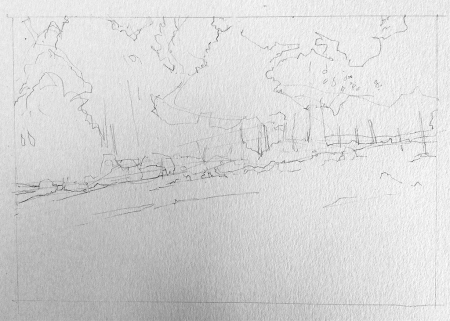
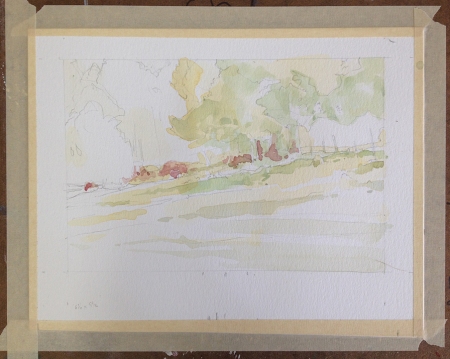
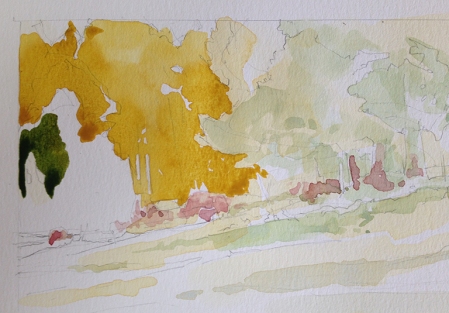
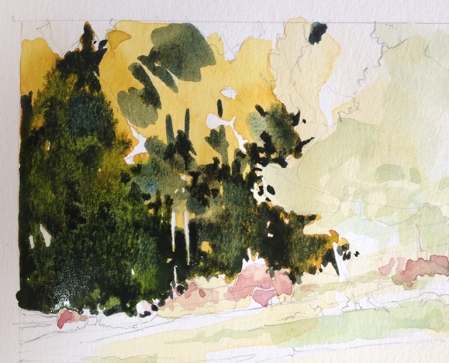
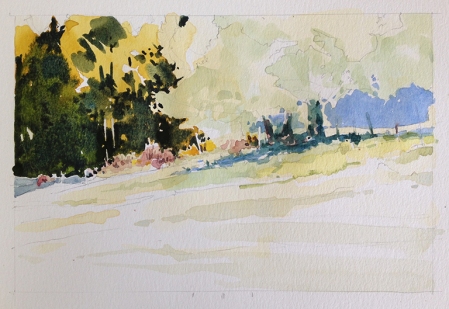
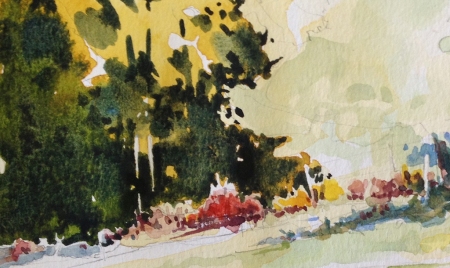
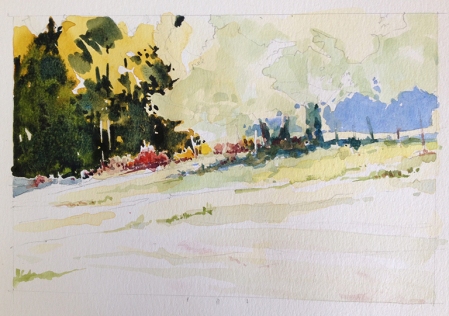
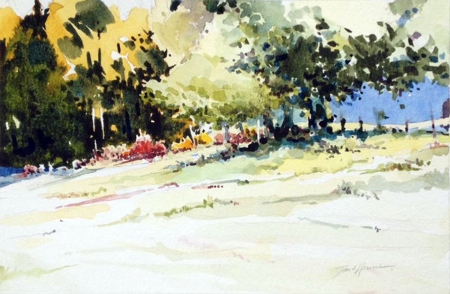
October 21, 2016 at 6:20 pm |
It’s not a sketch. 🙂
October 21, 2016 at 10:15 pm |
Ptg. 1, Sk. 0
My gut reaction is to agree … It certainly started down the sketch path but strayed way to far into the world of “paintings.”
October 21, 2016 at 8:32 pm |
I’m looking for a John Hancock that went to high school in Illinois. He was an artist also. Is this the same person?
October 21, 2016 at 10:11 pm |
No … not I said the little red-hen. FL, KS, & GA … no IL.
Sorry.
October 21, 2016 at 9:04 pm |
Wonderful work, John. Bona fide paintings, all.
October 21, 2016 at 10:15 pm |
Thanks!
October 22, 2016 at 7:25 am |
It is a superb painting that started with a small sketch using watercolors as a medium. Paintings are not oils, pastels, watercolors. Paintings are paintings and yours is an excellent one that happens to be executed with watercolor
October 22, 2016 at 9:04 am |
Hi John, Great, fresh little watercolor! I would not call this a sketch.
October 23, 2016 at 8:11 pm |
I think I agree … close to 99.44%
October 22, 2016 at 2:15 pm |
That’s ….artistic Freedom about breaking rules especially in watercolors. Don’t think to long how to ‘classify’ your piece, instead plan your next project.
October 23, 2016 at 8:22 pm |
Jerry,
ὁ … ἀνεξέταστος βίος οὐ βιωτὸς ἀνθρώπῳ!
I am always thinking about the nature of art
… and planning whole lifetimes of new work … including my next one!
In fact, the next two or three are always already started when I finish a piece.
All the best,
John
October 24, 2016 at 8:21 pm |
Not being in Art that long (a couple of years) my untrained mind says it is what you want…to me a sketch is a not quite finished painting or drawing used to prepare for or refer to for another work. This painting looks like a finished painting to me.
October 27, 2016 at 3:49 pm |
Mary, Thanks for looking and for your comment too!
October 24, 2016 at 11:49 pm |
I enjoyed following the process and progress from sketch to “what you want it to be” Either – or it is delightful and fresh.
October 27, 2016 at 3:50 pm |
Your words of encouragement are greatly appreciated! Thank you.
October 27, 2016 at 10:33 am |
My thought is – a sketch is used as an idea or preliminary for a larger completed picture. Your picture looks like a finished painting.
October 27, 2016 at 10:49 am |
Irene, Thanks for your post. Traditionally a sketch was an informal work … and was often used as a study, as a prepatory stage in the development of usually larger, more completed pieces. But, since the 1800s, more and more, we exhibit the informal sketch.
October 27, 2016 at 10:55 am |
I think this piece did end up going to far … to be a sketch in the modern sense. It could still be a traditional study in the sense as used from the Renaissance period forward.
October 29, 2016 at 4:02 pm |
John, I say “What does it matter”? A sketch is often within limited time and leaves a lot of white paper, or lacks detail. If you decided to work on it more (outside or at home) that is fine. There are no judges of this. Let the viewers label it. I see your paintings seem to leave a lot of white space (though I am having trouble maneuvering your website on my iMac) so some might see them as loose sketches, you might think of them as “paintings”. Look at abstract art. There are all kinds of stages there. Some leave a lot of white space too, and that is part of the composition. If you have a nice little sketch from a plein air session, you have the choice to leave it that way, or do more work on it. What difference does it make? You should be confident that your lovely sketches are as artful as what YOU identify as your “paintings”. http://www.pagesbyperetti.com
October 29, 2016 at 4:17 pm |
I am confident.
October 29, 2016 at 4:20 pm |
I was merely looking for an engaging discussion, the opinions of others. Not for vindication or validation … because ideas and images matter and are therefore quite interesting.
October 29, 2016 at 4:22 pm |
When I follow certain information on Artsy.com I see that thousands of dollars are garnered for “sketches” by Lucien Freud, Picasso, etc. So, they can be nearly as valuable as the “finished” work! Whoopeee!
October 29, 2016 at 4:29 pm |
Well, I agree. I only entered into the discussion in my own way. Is a sketch a painting? Depends on who is defining it probably. That’s my response. I just returned from the colorful fall woods of the Morton Arboretum, where due to recent surgery, I’ve been painting from the parked car! Using 2 water brushes (not my usual extensive equipment) I dashed off the oranges, yellows and browns of the season. Because I finished 3 in probably 45 min, they might be called sketches. But I could add ink lines for detail, and can scan them and make greeting cards from them. OR use them as a basis for a more extensive, drawn painting for framing and exhibits. All sorts of options!!!